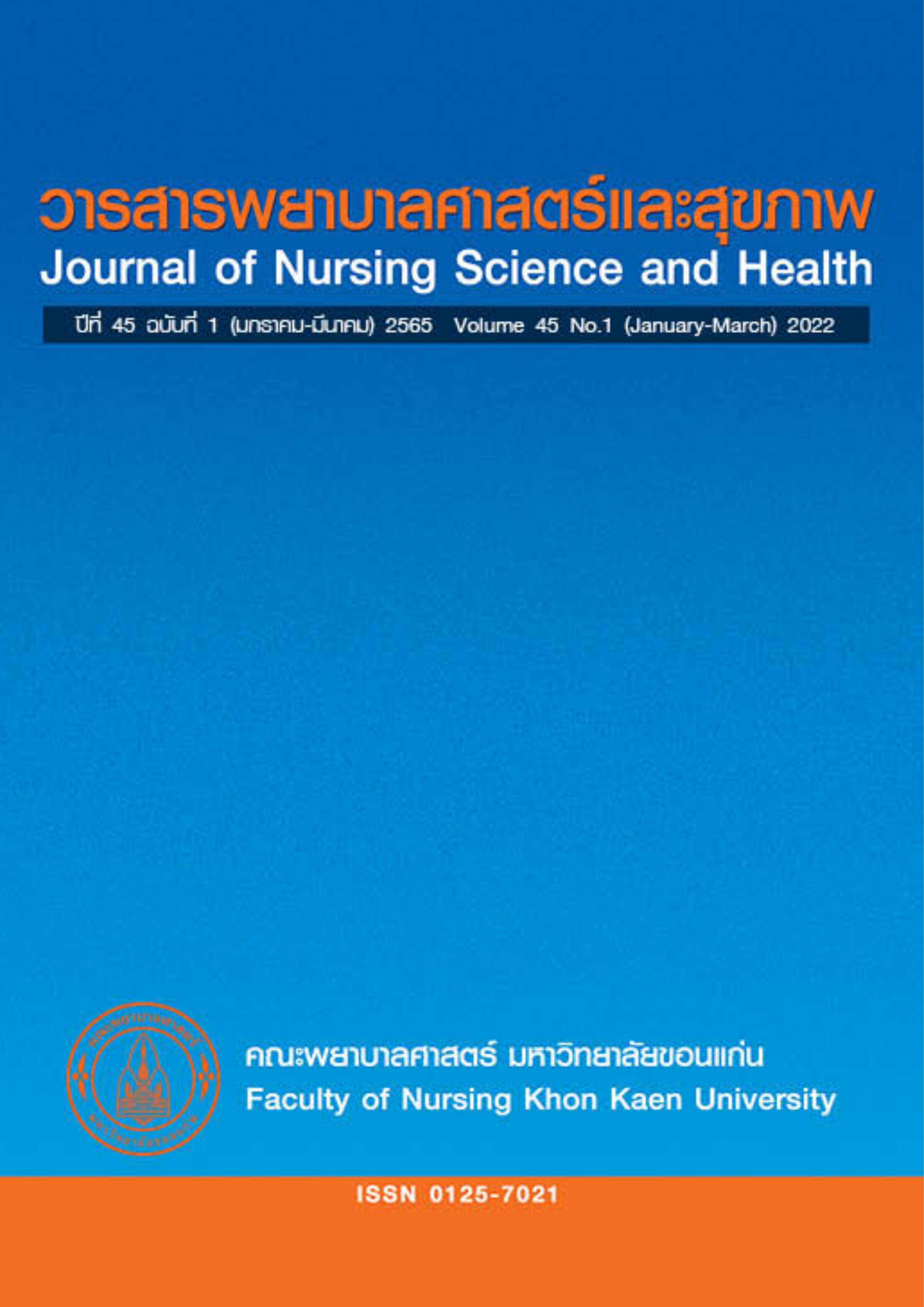ผลการประเมินอาการผู้ป่วยติดเชื้อในกระแสเลือด ตามเกณฑ์การประเมินอวัยวะล้มเหลว จากการติดเชื้อในกระแสเลือดแบบเร็ว หลักการดูแล 6 ข้อ และคะแนนการค้นหาความรุนแรง: การศึกษาย้อนหลัง
คำสำคัญ:
การประเมินความรุนแรงของอาการ , การประเมินอวัยวะล้มเหลวจากการติดเชื้อในกระแสเลือดแบบเร็ว, การศึกษาย้อนหลัง, ติดเชื้อในกระแสเลือดจากบ้านและชุมชน, หลักการดูแล 6 ข้อบทคัดย่อ
การติดเชื้อในกระแสเลือดทำให้อวัยวะต่าง ๆ ทำางานผิดปกติและเป็นสาเหตุของการเสียชีวิต การวิจัย
เชิงพรรณนาแบบย้อนหลังในผู้ป่วยติดเชื้อในกระแสเลือดจากบ้านและชุมชนนี้มีวัตถุประสงค์เพื่อประเมินผลการประเมินอาการผู้ป่วยติดเชื้อในกระแสเลือดจากบ้านและชุมชนตามเกณฑ์การประเมินอวัยวะล้มเหลวจากการติดเชื้อในกระแสเลือดแบบเร็ว หลักการดูแล 6 ข้อ และคะแนนการค้นหาความรุนแรง โดยใช้กรอบแนวคิดของ
โดนาบีเดียน ประเมินผลด้านกระบวนการและด้านผลลัพธ์ ศึกษาข้อมูลแบบเจาะจงจากเวชระเบียนผู้ป่วย จำนวน 210 ราย ในระหว่างวันที่ 1 เมษายน 2562 ถึง 31 มีนาคม 2563 ด้วยแบบบันทึกข้อมูลที่ผู้วิจัยสร้างขึ้น
ผลการวิจัยพบว่า ผู้ป่วยติดเชื้อในกระแสเลือดชนิดจากบ้านและชุมชนมีอายุเฉลี่ย 65.87 ปี ส่วนใหญ่เป็นกลุ่มผู้ป่วยสูงอายุ (ร้อยละ 69.2) และ มีโรคประจำตัว (ร้อยละ 63.3) ด้านกระบวนการพบว่า มีการคัดกรองผู้ป่วยโดยใช้แบบประเมินอวัยวะล้มเหลวจากการติดเชื้อในกระแสเลือดแบบเร็ว ร้อยละ 65.7 การปฏิบัติตามหลักการดูแล 6 ข้อ โดยการส่งเลือดเพาะเชื้อก่อนให้ยาปฏิชีวนะ ร้อยละ 83.8 ทั้งหมดมีการให้ยาปฏิชีวนะ แบบกว้างและใส่สายสวนปัสสาวะ (ร้อยละ 100) ให้สารน้ำ คริสตัลลอยด์ 30 มล./กก. ภายใน 1 ชั่วโมง ร้อยละ 98.6 ให้ยากระตุ้นความดันโลหิต ภายใน 1 ชั่วโมง ร้อยละ 39.5 ส่วนคะแนนความรุนแรงของอาการเมื่อแรกรับที่แผนกอายุรกรรมพบว่า สัดส่วนผู้มีคะแนน <4 และ ≥4 คะแนน คิดเป็นร้อยละ 30.9 และ ร้อยละ 69.1 ตามลำดับ โดยหลังจากนั้นมีการประเมินความรุนแรงของอาการอย่างต่อเนื่อง ร้อยละ 22.4 และ 10.8 ตามลำดับ ด้านผลลัพธ์พบว่า ผู้ป่วยมีค่าเฉลี่ยความดันหลอดเลือดแดง ≥65 มม.ปรอท ร้อยละ 60.5 มีค่าคะแนนความรุนแรง <4 คะแนน ร้อยละ 35.7 มีอัตราการเสียชีวิต ร้อยละ 45.7 และมีระยะเวลานอน
โรงพยาบาล เฉลี่ย 4.6 วัน
ข้อเสนอแนะ การประเมินความรุนแรงของอาการมีประโยชน์ในการดูแลผู้ป่วยติดเชื้อในกระแสเลือด
พยาบาลจึงควรมีความรู้ และทัศนคติ ในการประเมินอาการเปลี่ยนแปลง และป้องกันการเข้าสู่ภาวะวิกฤตในผู้ป่วยติดเชื้อในกระแสเลือด
เอกสารอ้างอิง
World Health Organization. WHO sepsis technical expert meeting 16-17 January 2018. [Internet]. 2018. [cited 2019 Jul 20]. Available from: https://www.who.int/
Ministry of Public Health. Details of indicators of the Ministry of Public Health. [Internet]. 2019.
[cited 2019 Jul 20]. Available from: https://www.moph.go.th (in Thai)
Radigan K. Severe sepsis and septic shock early management bundle. Critical Care Alert 2018;
(7): 53–4.
Levy MM, Evans LE, Rhodes A. The surviving sepsis campaign bundle: 2018 update. Intensive
Care Med 2018; 44(6): 925-8.
Champunot R, Permpikul C, Phajanasunthorn B. Practice guidelines caring for severe sepsis
and septic shock; 2015 [cited 2019 Jul 20]. Available from: http://www.ayhosp. go.th. (in Thai)
Bloos F, Thomas-Ruddel D, Ruddel H, Engel C, Schwarzkopf D, John CM. Impact of compliance with infection management guidelines on outcome in patients with severe sepsis: a prospective observational multi-center study. Critical Care 2014; 18(2): 2-10.
. Gupta S, Rudd KE, Tandhavanant S, Suntornsut P, Chetchotisakd P, Angus DC, et al. Predictive validity of the qSOFA score for sepsis in adults with community-onset staphylococcal infection
in Thailand. J Clin Med 2019; 8(11): 1908:2-10. doi: 10.3390/jcm8111908
Champunot R, Tansuphaswasdikul S, Kamsawang N, Tuandoung P, Himsri D. Application of search out severity (SOS) score for identification of deteriorating patients in general wards. Buddhachinaraj Med J 2016; 33(3): 313-25. (in Thai)
Jainadnarendra hospital. Statistic of sepsis patients. 2019. n.d. (in Thai)
Jainadnarendra hospital. Clinical practice guideline for sepsis. 2019. n.d. (in Thai)
Donabedian A. The quality of care. How can it be assessed. JAMA 1988; 260(12):1743-8.
Ministry of Public Health. Details of indicators of the Ministry of Public Health. [Internet].
[cited 2019 Jul 20]. Available from:https://www.moph.go.th. (in Thai)
Norwood SL. Research strategies. New Jersey:Prentice Hall, Inc., ; 2000.
Tian H et al. Accuracy of qSOFA for the diagnosis of sepsis-3: A secondary analysis of a population-based cohort study. JTD 2019; 11(5): 2034-42.
Lertvipapath P, Puttilerpong C, Werarak P,Chakorn T, Angkasekwinai N, Noppakusomboon N, et al. Comparison of clinical characteristics and treatment outcomes of sepsis or septic shock patients between those diagnosed by 2012 criteria and those by 2016 criteria. Thai J Pharm Prac 2017; 9(1): 205-15. (in Thai)
Rein PU, Jacobsen D, Ormaasen V, Djordjilović V, Dunlop O. A comparison of qSOFA and SIRS in the early diagnosis of severe pneumococcal sepsis: A retrospective cohort study. International Journal of Anesthetics and Anesthesiology 2020; 7(111):1-8.
Burke J, Wood S, Hermon A, Szakmany T. Improving outcome of sepsis on the ward: introducing the sepsis six bundle. BACCN 2018;24(1):33-9.
Martin-Loeches I, Guia MC, Vallecoccia MS, Suarez D, Ibarz M, Irazabal M, et al. Risk factors for mortality in elderly and very elderly critically ill patients with sepsis: A prospective, observational, multicenter cohort study. Ann Intensive Care 2019; 9(26): 1-9. doi:10.1186/s13613-019-0495-x.
Guarino et al. Predicting in-hospital mortality for sepsis: A comparison between qSOFA and modified qSOFA in a 2-year single-centre retrospective analysis. Euro J Clin Micro Inf Dis 2021; 40: 825–31.
Li Q, Wang J, Liu G, Xu M, Qin Y, Han Q, et al. Prompt admission to intensive care is associated with improved survival in patients with severe sepsis and/or septic shock. J Int Med Res 2018; 46(10):4071-81.
ดาวน์โหลด
เผยแพร่แล้ว
รูปแบบการอ้างอิง
ฉบับ
ประเภทบทความ
สัญญาอนุญาต
ลิขสิทธิ์ (c) 2022 วารสารพยาบาลศาสตร์และสุขภาพ

อนุญาตภายใต้เงื่อนไข Creative Commons Attribution-NonCommercial-NoDerivatives 4.0 International License.
วารสารพยาบาลศาสตร์และสุขภาพเป็นเจ้าของลิขสิทธิ์ในการเผยแพร่ผลงานที่ตีพิมพ์ห้ามผู้ใดนำบทความที่ได้รับการตีพิมพ์ในวารสารพยาบาลศาสตร์และสุขภาพไปเผยแพร่ในลักษณะต่าง ๆ ดังนี้ การนำบทความไปเผยแพร่ออนไลน์ การถ่ายเอกสารบทความเพื่อกิจกรรมที่ไม่ใช่การเรียนการสอน การส่งบทความไปตีพิมพ์เผยแพร่ที่อื่น ยกเว้นเสียแต่ได้รับอนุญาตจากวารสารพยาบาลศาสตร์และสุขภาพ



